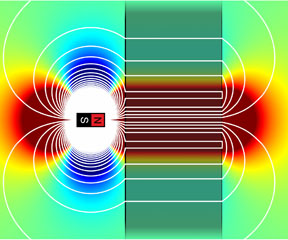A group of physicists have developed a technology to transfer magnetic fields to arbitrary long distances. Physicist Oriol Romero-Isart and his colleagues at the University of Innsbruck have theoretically proposed and then tested this new device. They are working with other scientists from the Universitat Autonoma de Barcelona, the Max-Planck-Institute of Quantum Optics, and the Institute for Quantum Optics and Quantum Information of the Austrian Academy of Sciences.
“Our studies have shown that we need a material with extreme anisotropic properties to transfer and route static magnetic fields,” explains Romero-Isart. This type of material has extremely good permeability in one direction but zero in the perpendicular direction. Since no material exists with such extreme anisotropy, the physicists used a different strategy: a ferromagnetic cylinder wrapped with a superconductor shell. “Superconductors are perfect magnetic insulators,” explains Romero-Isart. The researcher’s calculations showed that a structure of alternated superconducting and soft ferromagnetic concentric cylindrical layers could transfer more than 90% of the magnetic field to any distance. Remarkably, the researchers also calculated that up to 75% of the magnetic field can be transferred by using only a bilayer scheme — a ferromagnetic core with a superconducting outer layer.

An illustration of the transfer magnetic fields to arbitrary long distances. (Image: Universitat Autònoma de Barcelona )
A collaborating group lead by Alvaro Sanchez of the Autonomous University of Barcelona, Spain has designed a magnetic hose with alternating concentric cylinders of a high-permeability material (a ferromagnet) and a low-permeability material (a superconductor). Roughly speaking, when a source field is placed at one end of the cylinder, the ferromagnetic shells magnetize and regenerate the source field along the length of the cylinder, while the superconducting shells keep the field lines from spreading outward. The hose is better able to transfer a field as more layers are added, but that even a simple two-layer design is effective. The team made a two-layer magnetic hose 14 cm long out of a layer of superconducting yttrium barium copper oxide, wrapped around a cylinder made of a ferromagnetic iron alloy. They showed the field strength transferred was up to four times stronger than that transferred by a simpler hose made from only a ferromagnetic cylinder.
A paper on the work titled Long-Distance Transfer and Routing of Static Magnetic Fields has been published in the journal Physical Review Letters .
Advertisement
Learn more about Electronic Products Magazine





